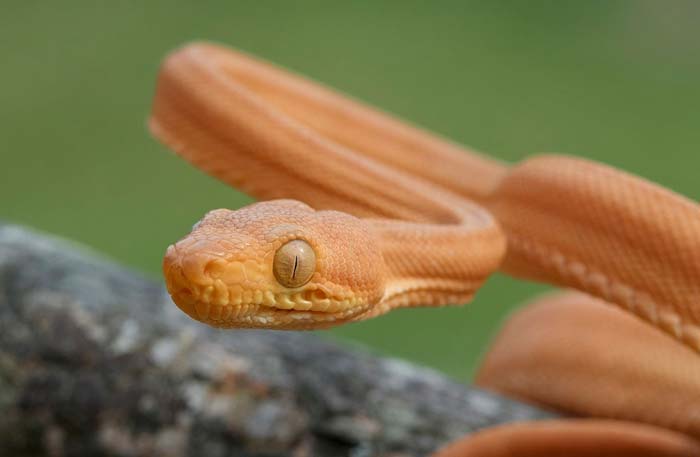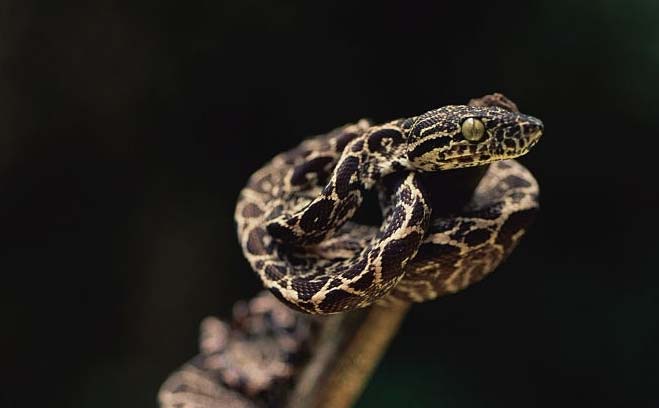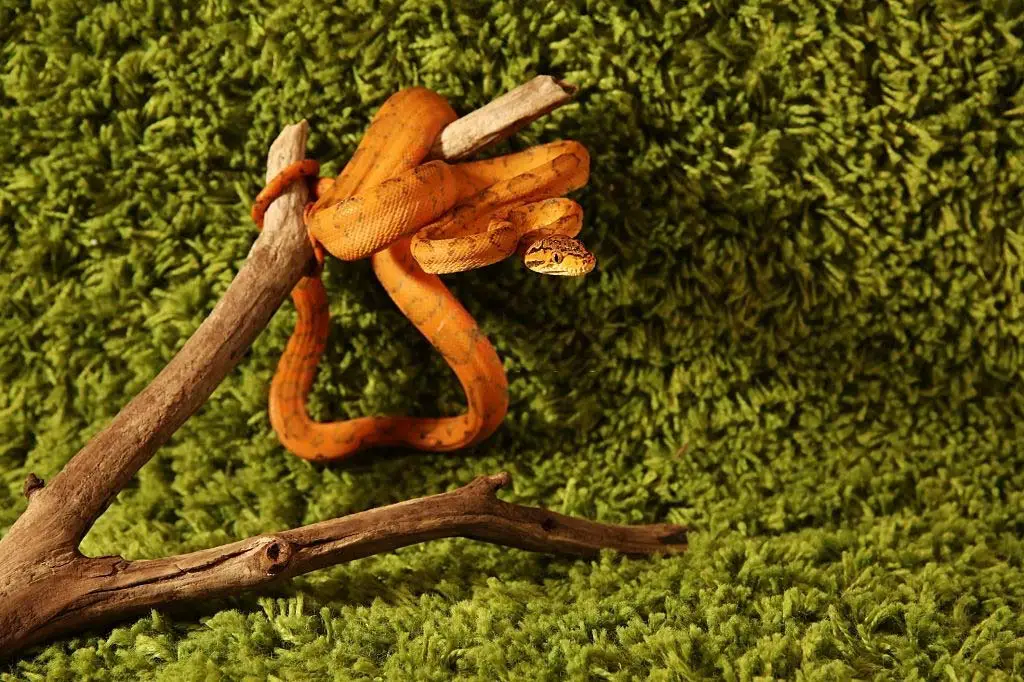In every litter, there is a surprise!
Amazon Tree Boas are stunning display snakes for any keeper who knows what they are doing. Amazon Tree Boas require an intermediate level of knowledge because they require specific enclosure setups and they can have a bit of a feisty personality.
These snakes are not for frequent handling. However, they do provide you with endless hours of captivating viewing. They are as beautiful, if not more, than the more expensive and aggressive Emerald Tree Boa and they are far more active and enjoyable to watch.
| Common Name: | Amazon Tree Boa, Amazon Tree Boa |
| Scientific Name: | Corallus hortulanus |
| Natural Habitat: | Arboreal |
| Adult Size: | 4 to 6 feet |
| Lifespan: | 12 to 20 years |
| Diet: | Rodents, bats, birds |
| Experience Level: | Intermediate to Advanced |
| Enclosure Size: | 36 tall X 36 long X 18 wide |
Reptile Overview
Owning and breeding Amazon Tree Boas is a rewarding experience as they are always being born with new morphs and displaying fantastic natural coloring. Some breeders target specific morphs and phases.
However, breeding for specific traits is tricky and every snake from a single litter can look different!
Amazon Tree Boas require specific enclosure care. This care must be maintained otherwise their life spans are cut short by several years.

As they are arboreal snakes, viewing them is incredibly satisfying as they climb over their perches and spread out, unlike Emerald Tree Boas or Green Tree Pythons who perch in one spot for most of the day.
Amazon Tree Boas are fantastic eaters and appreciate a varied diet. Fortunately, due to their smaller size, they will not eat you out of house and home.
Appearance
Amazon Tree Boas are long, slender snakes perfectly suited to winding themselves up in the branches of the canopy. They have heart-shaped heads that attach to surprisingly narrow necks. Their bodies expand from there and narrow again towards their long tails.
The females are slightly longer, thicker, and therefore heavier than the males. However, the sexually dimorphic traits end there.

These snakes have stunning eyes. They can be gold, silver, slightly red, or yellow and have a reflective layer over them that gives them a regal and chilling look.
There are a number of different morphs and phases that Amazon Tree Boas come in. They are the Garden Phase, the Colored Phase, the Paradox, the Tiger, the Leopard, and the Candy cane or Calico.
They can inherit their parents’ colors; however, determining the colors and patterning of the offspring is a complete guessing game.
Amazon Tree Boas can have multiple colors and undertones throughout their lives. They can range from jet-black, through various shades of brown and tan, to red, yellow, orange, and even lavender.
Temperament
These are feisty snakes with wicked personalities.
Amazon Tree Boas are arboreal snakes and have heat-sensing pits along their lips. In the wild, they strike out at warm-bodied prey items that zip through the canopy. Therefore, they are highly reactive snakes to anything with a heat signature.

This means that they will see a hand coming into their enclosure as food or foe and respond accordingly. This is why they make better display snakes than handling snakes. Juveniles are typically nippier than adults.
It will take consistent effort from you to maintain a schedule that your snake can get comfortable with to minimize the striking and defensive behavior.
Behavior
Even though they are mainly arboreal in nature, your Amazon Tree Boa will also spend some time on the floor of the enclosure and in their water bowl.
When they are moving through or perching in the vertical aspect of the enclosure they will spread out and perch on many surfaces. They do not typically drape themselves over a specific spot like an Emerald Tree Boa.
They are diurnal snakes, which means they are most active during the daytime.
Lifespan
Amazon Tree Boas can live between 12 and 20 years in captivity.
However, their lifespans can be drastically shortened if they are power fed, made obese, or have poor enclosure care.
Even with the best care, they do not typically outlive 20 years.
Enclosure
Amazon Tree Boas require a large enclosure that focuses on the vertical and horizontal aspects because they are active and use the space to remain stimulated and healthy.
An adult’s enclosure should be 36 tall X 36 long X 18 to 24 wide. If you can, always go bigger provided you equip the enclosure appropriately.
REPTI ZOO Large Glass Reptile Terrarium
A glass, plastic, or plexiglass enclosure is perfect. We do not suggest using wood as the humidity levels will encourage mold to grow. Mold is toxic to snakes and causes respiratory issues.
You can use a bioactive enclosure for your Amazon Tree Boa; however, it is not necessary. If you do use a bioactive enclosure, ensure that you research all plants and woods before you include them in the setup.
Your Amazon Tree Boa needs many perches at various levels throughout the vertical and horizontal aspects. These perches should intersect at many points to provide stability and a place for your snake to spread out.
The minimum thickness of the perches should be equal to the thickest part of your snake. You can use PVC pipes, real wood, cork hollows, artificial branches, etc. to make up the web of perches. Make sure all perches are securely anchored to the enclosure.
If you use natural wood, make sure you source it from an area that is not treated with herbicides or pesticides. If you do not know, you can sanitize the wood by boiling it in clean water and then baking it at a low temperature to dry it out completely.
Instead of or in addition to perches you can create a platform for your Amazon Tree Boa to utilize. Make sure this has some cover too.
The perches should have plenty of foliage on and around them to act as cover to provide security for your snake to move around and feel camouflaged.

The cover can be natural plant life. However, your snake will pull on and can damage the plants. We suggest using artificial foliage such as silk plants as they are easy to keep clean and last a long time.
The enclosure should be cleaned out and sanitized every 3 to 4 months. Poor enclosure hygiene can lead to dangerous infections and shorten your Amazon Tree Boa’s life span.
Substrate
Your Amazon Tree Boa requires high humidity so, we recommend using a substrate that holds moisture well.
Orchid bark, coconut husk, aspen or cypress shavings, sphagnum moss, or any combination will work well. Make sure to agitate the substrate every day and spot clean at the same time. Replace the substrate once a month.
It is important to spot clean every day, any fecal matter left in the enclosure can cause serious health problems for your Amazon Tree Boa.
Do not use pine or cedar shavings! They contain harmful oils that are toxic to your boa. They cause skin irritation and respiratory issues.
You can use butcher’s paper, newspaper, and paper towels as substrate too. These are cheap and easy to clean. Replace this substrate once a week.
If you have a bioactive enclosure, make sure to include isopods, springtails, and earthworms to help manage the health of the substrate.
Temperature
It is vital to your snake’s health to have a stable temperature gradient. As Amazon Tree Boas are arboreal, the temperature gradient needs to include the vertical aspect as well.
We suggest using a heating pad or tape that runs under a third of the enclosure and up one side wall. This will help keep the gradient even throughout the length and height of the enclosure.
VIVOSUN Reptile Heating Pad with Digital Thermostat
Place a basking lamp or ceramic heat emitter at the top corner of the enclosure on the hot side. Your Amazon Tree Boa will move around the enclosure to be at the perfect temperature that it needs to be.
Connect your heating elements to a thermostat to maintain control over them. Place two thermometers on the cool side and under the basking spot to constantly monitor the temperature gradient.
Zoo Med Labs Digital Hygrometer & Thermometer
Play around with the temperature settings BEFORE your snake comes home. Altering the temperature too much while your snake is in the enclosure can be fatal.
Cool Side: 75°F
Warm Side: 85°F
Basking Area: 90°F
There should be hide boxes on the floor of the enclosure on the warm and cool sides. You can create hides in the vertical aspect too by using hollow PVC pipes or cork rounds that are covered by foliage.
Hide boxes are essential to your Amazon Tree Boa’s health. They provide a place for your snake to destress. They should be big enough for your snake to fit its whole body into but small enough that it is a snug fit.
Lighting
Your Amazon Tree Boa requires a 12/12 light/dark photocycle. We suggest placing your lights on a timer as to not make mistakes and to maintain a regular schedule. Remember, maintaining a regular schedule will help keep your Amazon Tree Boa from being too reactive.
Zoo Med Reptisun LED Terrarium Hood
Your Amazon Tree Boa does not need special full spectrum lighting. Some studies have indicated that too much UV lighting can cause their eyes to go cloudy.
You can keep your Amazon Tree Boa in a room that has natural lighting, provided sunlight does not fall directly on the enclosure as this will raise the temperature enough to cook your snake.
Snakes do not bark or cry when something is wrong so you need to make an extra effort when caring for them.
Humidity
Amazon Tree Boas need a humidity range of 45% to 75% depending on where they are in their shedding cycle.
They need the higher end when they are shedding.
The increased humidity will make it easier for the old skin to shed and not become stuck. When you snake is in shed, you should mist the enclosure daily so that the humidity level spikes close to 90% and then falls back to normal range during the day.
When they are not in shed, the humidity level can drop to 45% but should not go any lower as this can lead to shedding problems and skin issues.
There are a number of ways you can maintain the humidity:
- Misting once or twice a day
- Install misters to mist at selected times
- Include live plants such as ferns in the enclosure
- Create a humid hide box – line an opaque hide box with damp sphagnum moss and place it on the warm side of the enclosure
- Wet a ball of paper towel and place it in the enclosure at the 85°F mark and the moisture will evaporate steadily throughout the day
Galápagos Terrarium Sphagnum Moss
You MUST include a quality hygrometer in the enclosure to monitor the humidity levels at all time.
Diet
Amazon Tree Boas love water and should have access to a water bowl at all times. However, there are a few things you need to keep in mind. The water bowl must:
- Be big enough to fit the whole snake in it
- Be heavy enough not to tip over
- Be deep enough not to slosh excess water over the side
- Be refreshed daily with clean water
- Must not be porous as this will increase the humidity levels
Amazon Tree Boas are great eaters from the time they are born. They can be fed mainly mice and rat pups but should get a varied diet including chicks, anodes, and other items.
We always recommend Frozen/Thawed (F/T) prey items.
Feeding your snake live prey can be problematic for a number of reasons. Live prey can carry parasites and disease, they can attack and damage your snake, they come with their own set of care and cost requirements.
When it comes to feeding time, take the frozen item and put it in a bowl of hot water. When it is completely thawed, you can feed it to your Amazon Tree Boa in its enclosure. Do not feed your snake partially frozen prey as the temperature difference will kill them.
Your juvenile Amazon Tree Boa should be fed once every 7 days and your adult should be fed once every 10 to 14 days.
Feed your Amazon Tree Boa one prey item of appropriate size. Use our sizing guideline to help you:
Largest point of girth of prey = Largest point of girth of snake not including head
Do not power feed or over feed your Amazon Tree Boa. This will shorten their lifespan considerably.
Your Amazon Tree Boa will generally always accept food. They might refuse during the opaque stage of their shed.
Handling
As mentioned previously, the Amazon Tree Boa is not the snake for frequent handling. They are delicate and feisty specimens.
They have incredibly thin prehensile tails that they use to wrap around branches to anchor themselves. If their tail is damaged, it can prevent the snake from climbing safely or even at all.
We suggest hook training your snake. This means that the snake will eventually associate the hook with handling and not with food. Never smell like their prey items when you want to handle them.
Amazon Tree Boas are able to sense miniscule changes in temperature.
They know the difference between a human and a mouse. However, if you do not give them the chance to read your thermal signature and surprise them by reaching into their enclosure they will react defensively.
Be calm and gently coax them off their perch or remove the entire perch that their tail is wrapped around. Always support their body when you handle them.
Remain calm and controlled and do not make rapid movements to prompt a reactive response.
Potential Health Issues
Parasites
Mites are external parasites that burrow under the scales to get at the snake’s blood. They carry their own internal parasites so getting rid of them is important.
If your Amazon Tree Boa is soaking excessively or you can see small black dots on them or the substrate then you need to do a full sanitization of their enclosure.
If you have other reptiles, check them for mites too.
Obesity
Obesity is the leading cause of death in Amazon Tree Boas. They are thin delicate snakes that need to remain that way.
Fat snakes are not funny snakes. Obesity puts strain on the heart and other organs and is fatal.
Respiratory issues
If the humidity levels are too high, too often then your Amazon Tree Boa can develop a respiratory infection. You will notice that they will bubble and gurgle while they breathe. They will also breathe with their mouths open.
Get your snake to a vet ASAP and adjust your humidity levels.
Breeding
Amazon Tree Boas should not be bred if they are under 3 years old. Ensure that they are in good health before you breed them.
A brumation period is necessary to increase the chances of successful breeding.
At the beginning of winter reduce the overall temperature of the enclosure by 5°F to 10°F. Do not let the temperature drop below 65°F. Increase misting and raise the humidity levels to 90%. Conditions like these tell the snake breeding season is approaching.
These adjustments must be done slowly. If they are done too fast you can cause serious harm.

Introduce the male to the female’s enclosure instead of the other way around. You can leave him in the enclosure for a month or a week at a time if he is being cycled between different females.
Do not feed your Amazon Tree Boas in the same enclosure. They have a high prey drive and can attack each other when food is involved.
After a month remove the male, the female should be gravid.
You will see this as a slight bulge in her belly that will grow over time. Return her enclosure settings to normal slowly.
Your female will be ‘pregnant’ for roughly 160 days. She may go off food the closer it gets to ‘birthing’ time. We say pregnant because Amazon Tree Boas are ovoviviparous snakes which means they keep the eggs inside the body and birth ‘live’ young.

Your female will do a pre-birthing shed. When this happens place a moist birthing box in her enclosure that is lined with newspaper, paper towel, or sphagnum moss. She should be able to fit in the box comfortably.
Once she gives birth, remove the babies very carefully to their own enclosures. Resume a normal feeding schedule for the female.
If you are aiming to breed specific colors and patterns, make sure you get a full genetic hereditary report from the breeder before you purchase your snake. Even if you have got this report, there is a good chance you will have no idea what your baby snakes will look like.
Conclusion
Amazon Tree Boas are fascinating snakes to own and ogle throughout the day. They do not make good handling snakes but they make up for it by being striking and very active.
Amazon Tree Boas are frequently available for new owners to purchase. However, we do rate them as intermediate-level snakes because their handling and care requirements are specialized and can become difficult.
We wish you luck and ‘herp’ your journey with your new ‘boa’ friend is a successful one!
Related:











